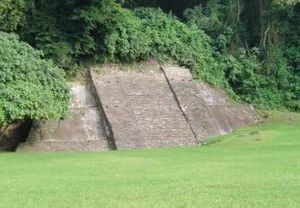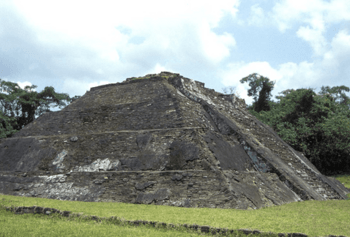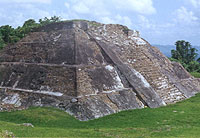Cuyuxquihui facts for kids
|
|
|
| Name: | Cuyuxquihui |
| Location | Paso de Correo, Papantla, Veracruz |
| Coordinates | 20°18′17.83″N 97°15′43.94″W / 20.3049528°N 97.2622056°W |
| Culture | Totonac – Tepehua |
| Period | Postclassical |
| Foundation | Around 1,250 CE. |
| Decline | Final Postclassical |
| Language | Totonac |
| INAH Official Page | Not available |
Cuyuxquihui is an ancient archaeological site in Veracruz, Mexico. It's found in the Tecolutla valley. This area was once home to the Totonac culture. The site is about 22 kilometers (13.7 miles) southeast of El Tajín. It is also about 5 kilometers (3.1 miles) southeast of Paso de Correo.
The name Cuyuxquihui comes from the Totonac language. Cuyu means armadillo and quihui means wood. The name likely describes how the local plants and trees look similar to an armadillo's shell. This site is about 74 kilometers (46 miles) southwest of Las Higueras (archaeological site). Las Higueras is another important Totonac site.
Contents
Discover the Totonac Culture
The Totonac culture was a major civilization in ancient Mexico. Their name might mean "three hearts." This could refer to their three main cultural centers:
- El Tajín (300-1200 CE): This was the most important Totonac city. It showed the peak of their culture.
- Papantla (900-1519 CE): Another significant city during their later period.
- Zempoala (900-1519 CE): Also a key center in the Totonac world.
The Totonacs were skilled artists and builders. They made many different types of pottery. They also created amazing stone sculptures. Their cities had impressive buildings and were well-planned. The Totonac languages are a group of related languages. About 200,000 Totonac and Tepehua people still speak them today. These languages are mainly spoken in Veracruz, Puebla, and Hidalgo in Mexico.
Exploring the Cuyuxquihui Site
Cuyuxquihui seems to have been built like a fortress. This is because of its special design. It has strong walls that run from north to south. These walls make it hard to reach from the west. A steep cliff on the east side also protects it. Experts believe it was needed because many people were moving around after El Tajín fell.
Other ancient settlements in the area show that some were built at the same time as El Tajín. Others grew after El Tajín was slowly left empty. Evidence suggests that Cuyuxquihui was founded around 1250 CE.
Cuyuxquihui became an important place for ceremonies. This happened after El Tajín started to decline. Many structures were built by leveling the ground. This was a common building method at the "Tajín Chico" site. The first buildings used carefully chosen materials. These were put together with mortar. Then, they were covered with thick stucco and painted.
The Aztecs conquered Cuyuxquihui around 1465 CE. This happened under Moctezuma Ilhuicamina (1398 – 1469). This conquest likely led to a mix of cultures. You can see Totonac, Mexica, and Huastec influences at the site.
Main Buildings at Cuyuxquihui
Here are some of the most important buildings at Cuyuxquihui:
Building 1: The Pyramid
This building is a pyramid with four levels. It also has a small, upright wall. Traces of blue and red paint were found on it. Inside, archaeologists found a knife, fine pottery, and tablets. These tablets had carvings of Quetzalcoatl, a feathered serpent god. These finds suggest that Building 1 was used for special religious ceremonies.
South Building: The Oldest Structure
This building is thought to be the oldest one at the site.
Building III: The Monolith Structure
At the top of this building, a 2-meter (6.5-foot) tall stone pillar was found. This pillar, called a monolith, shows signs of being changed three times. The last changes were made around 1400 CE. They show influences from the Aztec culture.
Buildings IV and V: The "Two Jointed" Structures
These two buildings are also known as "dos unidos," meaning "two jointed." Both have a small platform at the top. There was probably another building on top of these platforms, but it is no longer there.
Ballgame Court: An Ancient Sport Arena
The ballgame court is shaped like the letter "I." It is 72 meters (236 feet) long and 4 meters (13 feet) wide. It was built on a natural slope in the land.
See also
 In Spanish: Cuyuxquihui para niños
In Spanish: Cuyuxquihui para niños




